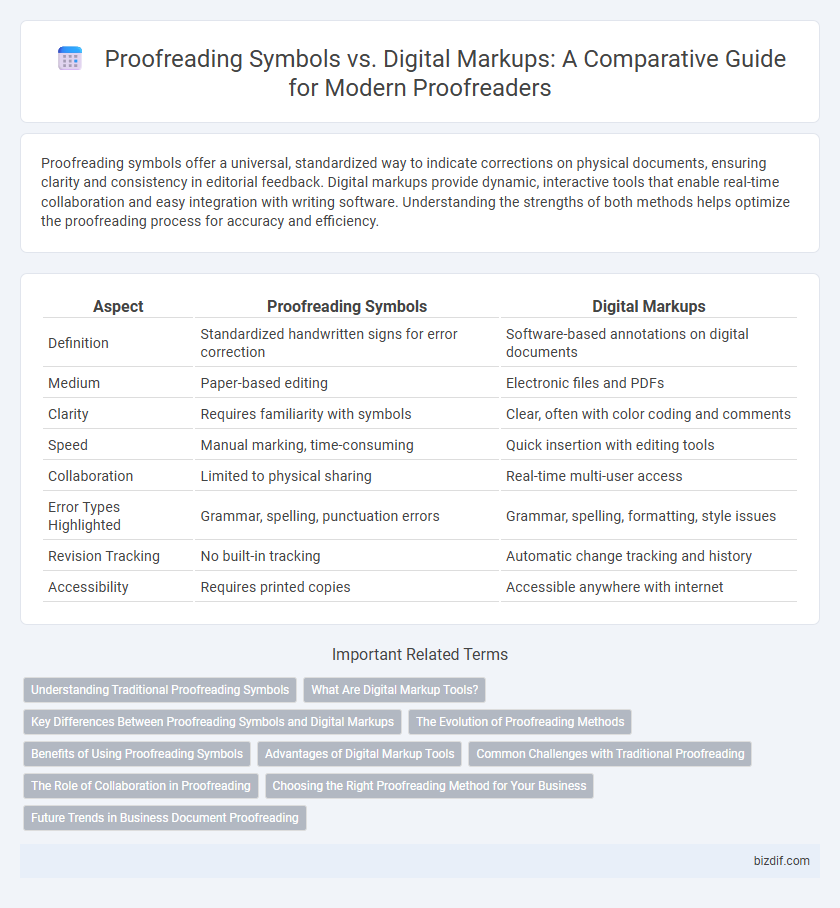Proofreading symbols offer a universal, standardized way to indicate corrections on physical documents, ensuring clarity and consistency in editorial feedback. Digital markups provide dynamic, interactive tools that enable real-time collaboration and easy integration with writing software. Understanding the strengths of both methods helps optimize the proofreading process for accuracy and efficiency.
Table of Comparison
| Aspect | Proofreading Symbols | Digital Markups |
|---|---|---|
| Definition | Standardized handwritten signs for error correction | Software-based annotations on digital documents |
| Medium | Paper-based editing | Electronic files and PDFs |
| Clarity | Requires familiarity with symbols | Clear, often with color coding and comments |
| Speed | Manual marking, time-consuming | Quick insertion with editing tools |
| Collaboration | Limited to physical sharing | Real-time multi-user access |
| Error Types Highlighted | Grammar, spelling, punctuation errors | Grammar, spelling, formatting, style issues |
| Revision Tracking | No built-in tracking | Automatic change tracking and history |
| Accessibility | Requires printed copies | Accessible anywhere with internet |
Understanding Traditional Proofreading Symbols
Traditional proofreading symbols are a standardized set of marks used to indicate corrections and editorial changes on printed manuscripts, ensuring precise communication between authors and editors. These symbols include marks for insertion, deletion, transposition, and formatting adjustments, making them essential for manual text editing and print media workflows. Mastery of these symbols enhances accuracy in identifying and correcting errors before digital tools transform the editing process.
What Are Digital Markup Tools?
Digital markup tools are software applications designed to annotate, highlight, and comment on electronic documents, facilitating efficient collaboration and error correction. These tools often include features such as track changes, insert comments, and real-time editing, enabling precise revisions without altering the original content. Popular digital markup platforms include Adobe Acrobat, Microsoft Word, and Google Docs, which support seamless integration and version control in proofreading workflows.
Key Differences Between Proofreading Symbols and Digital Markups
Proofreading symbols offer a standardized, handwritten method for indicating text corrections directly on paper, whereas digital markups utilize software tools to highlight, comment, and track changes in electronic documents. Proofreading symbols rely on universally recognized signs such as insertion marks, deletion lines, and transposition symbols, while digital markups provide versatile features like color coding, hyperlinking, and real-time collaboration. The key difference lies in the transition from analog to digital workflows, impacting speed, clarity, and the ease of implementing corrections in various publishing environments.
The Evolution of Proofreading Methods
Proofreading symbols have historically provided a standardized visual code for editors to indicate corrections on physical manuscripts, ensuring clear communication between writers and proofreaders. Digital markups have revolutionized this process by enabling real-time, collaborative editing with tools like track changes and comment features in word processors such as Microsoft Word and Google Docs. This evolution enhances accuracy, efficiency, and accessibility in proofreading, reflecting the shift from manual to digital workflows in publishing and content creation.
Benefits of Using Proofreading Symbols
Proofreading symbols offer a universally recognized visual language that enhances clarity and precision in editing, enabling quicker identification and correction of errors compared to digital markups. Their consistent usage facilitates effective communication between writers and editors, minimizing misunderstandings and ensuring detailed attention to grammar, punctuation, and formatting. These symbols also allow for efficient paper-based reviews, supporting workflows where digital tools may be unavailable or impractical.
Advantages of Digital Markup Tools
Digital markup tools enhance proofreading efficiency by enabling real-time collaboration and precise, customizable annotations. These tools integrate seamlessly with various document formats, offering cloud-based access and automatic version control to reduce errors and streamline workflow. Advanced features such as searchable comments, instant updates, and easy tracking of changes significantly improve accuracy and turnaround time compared to traditional proofreading symbols.
Common Challenges with Traditional Proofreading
Traditional proofreading using symbols often leads to misinterpretation due to varying standards and handwriting clarity, causing delays in revision processes. Digital markups offer enhanced precision and efficiency by allowing direct text comments and real-time collaboration, mitigating ambiguity. However, transitioning from traditional symbols to digital tools can pose challenges such as user adaptation and software compatibility.
The Role of Collaboration in Proofreading
Collaboration enhances the proofreading process by combining traditional proofreading symbols with digital markups, ensuring clarity and precision in edits. Digital tools facilitate real-time feedback and seamless communication among team members, accelerating error detection and resolution. Integrating both methods leverages the strengths of tactile annotations and efficient digital workflows, fostering a more effective collaborative environment.
Choosing the Right Proofreading Method for Your Business
Proofreading symbols offer a traditional, universally recognized method for editing printed documents, making them ideal for legal, academic, or publishing industries requiring precise manual corrections. Digital markups provide dynamic, real-time collaboration features and integration with software tools, enhancing efficiency for businesses relying on cloud-based workflows and remote teams. Selecting the right proofreading method depends on factors such as document format, team structure, and the necessity for traceability versus rapid iterative edits.
Future Trends in Business Document Proofreading
Emerging trends in business document proofreading increasingly favor digital markups for their efficiency and seamless integration with collaborative platforms, enhancing real-time editing and version control. While traditional proofreading symbols remain valuable for detailed manual reviews, AI-driven tools and cloud-based solutions are set to dominate by automating error detection and streamlining feedback processes. This evolution supports faster turnaround times and improved accuracy in corporate communication workflows.
Proofreading Symbols vs Digital Markups Infographic

 bizdif.com
bizdif.com